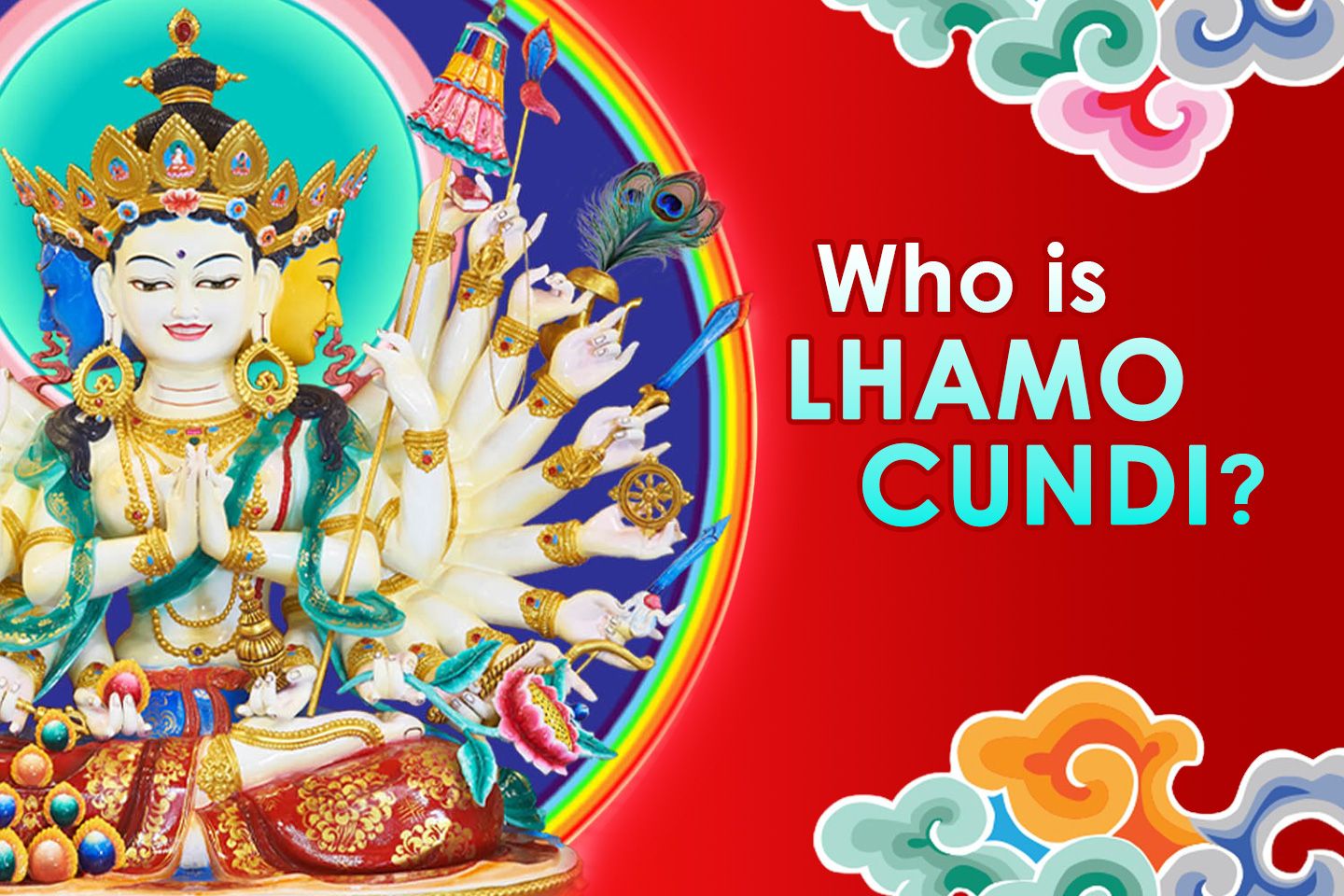Who is Lhamo Cundi?

Cundi has long been honored for her powerful blessings that bring both spiritual and worldly achievements.
Therefore, individuals may seek Cundi's support for gaining insights into Dharma, advancing in business or personal careers, fostering a harmonious family, or improving interpersonal relationships by making offerings and praying to her.
By earnestly engaging in practices with Arya Cundi, we can purify vast amounts of negative karma, including that accumulated from broken vows. Cundi helps us in dispelling misunderstandings and animosity within ourselves and towards others that stem from wrong views. She also safeguards us from life’s obstacles caused by non-human entities and has the power to turn challenging conditions into favorable ones. This article will explain who Lhamo Cundi is and the significance of her practice.
Lhamo Cundi is also Bodhisattva Zhunti (准提菩萨)
A popular but mysterious deity in the Buddhist world, Cundi is currently most actively venerated amongst Buddhists from East Asian traditions in the form of the one-faced eighteen-armed Bodhisattva Zhunti (准提菩萨). Amongst many local Chinese devotees, she is seen to be a manifestation of Bodhisattva Avalokitesvara, and some may refer to her as the Eighteen-Armed Guanyin (十八手观音). Of the numerous Chinese temples that honours Eighteen-Armed Guanyin in Singapore, the most renowned one is Kwan Im Thong Hood Cho Temple at Waterloo Street.
Lhamo Cundi has gone by many names over the centuries. She was originally named Cunda, but over the years as her veneration spread, she also came to be known as Cundi. The name Cundi was translated into Mandarin Chinese as ‘Zhunti’, which then was translated into Japanese as ‘Jundei’. Chinese speakers thus refer to her variously as Zhǔntí Púsà (Bodhisattva Zhunti), Zhǔntí Fómǔ (Buddha-Mother Zhunti) or Zhǔntí Guānyīn (Avalokitesvara Zhunti), while Japanese speakers mostly know her as Jundei Kannon (Avalokitesvara Zhunti), where she is mostly placed within Shingon Buddhist tradition.
The sutra that most features Cundi is the Cundi Dharani Sutra, which clearly lays out the powerful benefits of reciting her dharani, and outlines methods of practicing to manifest her blessings.
Just as Avalokitesvara comes in countless forms to best benefit sentient beings, there are myriad manifestations of Cundi to suit the propensities of different people, such as the four-armed, sixteen-armed, eighteen-armed and twenty-six armed forms.
Her arms wield both peaceful and wrathful implements, allowing her to swiftly and efficiently help sentient beings in all directions. She is powerful and can accomplish many objectives for the benefit of all sentient beings and their enlightenment.
Lhamo Cundi in Tibetan Buddhist Lineage
Lhamo means goddess in Tibetan, which is a form of veneration for female Buddhas, Bodhisattvas, or protector deities, while Cundi is a feminine form of the male name Cunda. Whilst Cundi’s practices are not as widespread within the Tibetan Buddhist tradition, we are very fortunate to have received the uncommon unbroken esoteric lineage of the three-faced twenty-six armed manifestation of Lhamo Cundi. This lineage can be traced back to India through generations of monastics and yogis, and has been kept alive over the centuries in the face of invasions and religious persecutions.
This rare form of Lhamo Cundi can be found within the Vajrayana tradition and textual records include the Goddess Cunda sadhana within the Rinjung Gyatsa, a vast collection of Vajrayana deities, compiled in the 16th century by Tibetan master Lama Taranatha. She is also detailed in the chapter on the Manjuvajra Mandala within the Nispannayogavali, a book on Buddhist iconography written by the great Buddhist pandit Abhayakara Gupta of the influential Vikramsila monastery located in modern day India circa 1084-1130.
Special Uncommon Cundi Rupa at Thekchen Choling Singapore
We have recently enshrined an uncommon form of Lhamo Cundi at Thekchen Choling Singapore. She is of the lineage of three faces and twenty-six arms, and is a highly hidden and secret practice. Her blessings are vast and powerful, and she can swiftly fulfill worldly and spiritual goals. She is also the secret manifestation of Mother Tara.
This unique Lhamo Cundi Rupa was specially made in India, and was consecrated in September 2024.
Every month, the temple will recite Buddha Pronounces the Sutra of The Great Cundi Dharani The Heart of The Mother of Seven Koti Buddhas (佛说七俱胝佛母心大准提陀罗尼经). We dedicate the merits of this Sutra to the welfare and awakening of all sentient beings.
Conclusion
Join us for our annual Grand Sanctification Ceremony of Cundi 2024! As bestowed by H.E. Jhado Rinpoche, Lhamo Cundi is the patron deity of Thekchen Choling. He had especially transmitted the esoteric lineage of Lhamo Cundi to our Spiritual Director Singha Rinpoche, thus establishing a direct connection between our temple and Cundi practice. This precious lineage is to be kept alive through our practices, to benefit all sentient beings in their path to enlightenment.
During the Grand Sanctification Ceremony of Cundi, we make strong supplications to Cundi as a group. Throughout the entire ceremony lasting three days and two nights, Lhamo Cundi’s short mantra “Om Tsale Tsule Cundi Svaha” will be chanted continuously. Practicing collectively like this greatly magnifies our efforts, bestowing multitudes of blessings and benefits. Through this powerful ceremony, we pray for the happiness of all sentient beings, long and stable lives of our Lineage Gurus, as well as the quick fruition of all our virtuous wishes and that of our sponsors’ and devotees’.
Come participate in this prayer ceremony with us—for those who cultivate a strong link with her, through effective practice she will lead us all the way to enlightenment. There will be on-site and online participations for you to choose from. Each session lasts 2.5 hours and we have limited slots for each session. There are also other languages for both on-site and online sessions, Chinese and Vietnamese, on certain days. Click here to find out more.

